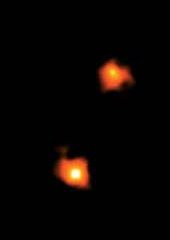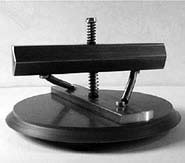Physics and Astronomy
This area deals with the fundamental laws and building blocks of nature and how they interact, the properties and the behavior of matter, and research into space and time and their structures.
innovations-report provides in-depth reports and articles on subjects such as astrophysics, laser technologies, nuclear, quantum, particle and solid-state physics, nanotechnologies, planetary research and findings (Mars, Venus) and developments related to the Hubble Telescope.

Chameleon particles from the Sun
The Sun emits electron-neutrinos, elementary particles of matter that have no electric charge and very little mass, created in vast numbers by the thermonuclear reactions that fuel our parent star. Since the early 1970s, several experiments have detected neutrinos arriving on Earth, but they have found only a fraction of the number expected from detailed theories of energy production in the Sun. This meant there was either something wrong with our theories of the Sun, or our understanding of neutrino

New evidence for organic compounds in deep space
The mysterious spectral bands in the infrared of interstellar gas clouds in deep space originate from organic compounds. Research by the Nijmegen physicist Hans Piest confirms this. He has provided new experimental evidence for this almost 30-year-old problem in astronomy.
Each molecule has specific wavelengths at which it can either absorb or emit light. This forms the fingerprint of a substance. With this fingerprint, astronomers can demonstrate the presence of a substance in a distant sta

Scientists blow their own trumpet
Brass instrument makers could soon be using the latest technology to refine the manufacturing of trumpets and cornets. An improved way of taking internal measurements of musical instruments, published today in the Institute of Physics journal, Measurement Science and Technology, has been developed by scientists at the University of Edinburgh, the Open University and Smith-Watkins Brass.
In a trumpet or cornet the musical qualities of the instrument, for example the tone, response and intonat

Rocks twirl in remote two-step
One lump of rock is revealed as two in the distant Kuiper belt.
The stand-offish dance of two asteroids at the outer reaches of the Solar System is captivating astronomers. The two rocky objects, discovered locked in mutual orbit, could tell us about the properties of the far-flung Kuiper belt.
Christian Veillet and his team 1 studied an object called 1998 WW31 in the Kuiper belt, a sparsely populated region of space beyond the orbit of Neptune. The object w

In SOHO’s pictures, watch a comet passing near the Sun
Between now and Saturday, 20 April, you can follow via the Internet the progress of the new-found Comet SOHO-422. Usually, comets seen by the SOHO spacecraft quickly burn up in the Sun’s hot atmosphere. This one won’t, so there is still time to monitor its progress.
Like most of the hundreds of comets found with the ESA-NASA sun-watching spacecraft, SOHO-422 was first noticed by an amateur astronomer. Pictures from SOHO are made available, freely and rapidly, on the Internet. Peop

Noise put to work
Random vibrations can generate rotation.
A simple top converts foghorn noise to one-way spin. The device raises the hope that useful energy could be collected from ambient sounds. Normally, random vibrations, which physicists and engineers call noise, produce useless random motion. You can’t move a cart from A to B by shoving it randomly in every direction.
But in the new device, made by Yaroslav Zolotaryuk of the Technical University of Denmark in Lyngby and colleagues